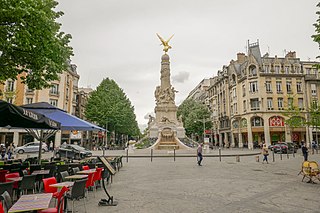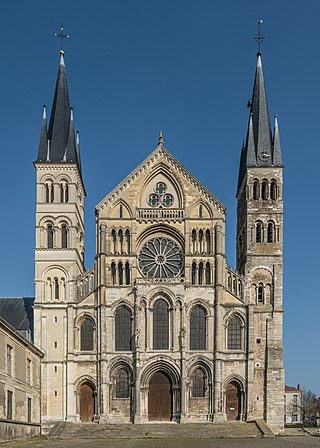Contents
This article needs additional citations for verification .(February 2024) |
| 1030s .1040s in architecture. 1050s |
| Architecture timeline |
This article needs additional citations for verification .(February 2024) |
| 1030s .1040s in architecture. 1050s |
| Architecture timeline |

The 11th century is the period from 1001 through 1100 (MC) in accordance with the Julian calendar, and the 1st century of the 2nd millennium.

Reims is the most populous city in the French department of Marne, and the 12th most populous city in France. The city lies 129 km (80 mi) northeast of Paris on the Vesle river, a tributary of the Aisne.

A pagoda is a tiered tower with multiple eaves common to Thailand, Cambodia, Nepal, China, Japan, Korea, Myanmar, Vietnam, and other parts of Asia. Most pagodas were built to have a religious function, most often Buddhist, but sometimes Taoist, and were often located in or near viharas. The pagoda traces its origins to the stupa, while its design was developed in ancient India. Chinese pagodas are a traditional part of Chinese architecture. In addition to religious use, since ancient times Chinese pagodas have been praised for the spectacular views they offer, and many classical poems attest to the joy of scaling pagodas.

Zhengding, originally Zhending, is a county in southwestern Hebei Province, North China, located approximately 260 km (160 mi) south of Beijing, capital of China. It is under the administration of the prefecture-level city of Shijiazhuang, the capital of the province, and has a population of 594,000. Zhengding has been an important religious center for more than 1,000 years, from at least the times of the Sui dynasty to the Qing dynasty. It is the founding place of several major schools of Chan Buddhism. However, many former religious building complexes have been severely damaged throughout history. A noted temple is the Longxing Monastery, where the historical building ensemble has been preserved almost intact. Furthermore, four famous pagodas, each with its own architectural style, are still standing.

The Musée Saint-Remi is an archeology and art museum in Reims, France. The museum is housed in the former Abbey of Saint-Remi, founded in the sixth century and which had been keeping since 1099 the relics of Saint Remigius. The Basilica of Saint-Remi, adjacent to it and consecrated in 1049, was its abbey church. Both buildings have been listed as part of a UNESCO World Heritage Site since 1991 because of their outstanding architecture and importance in the early French monarchy.

The Iron Pagoda of Youguo Temple (佑國寺), Kaifeng City, Henan province, is a Chinese pagoda built in 1049. The pagoda is so-named not because it is made of iron, but because its color resembles that of iron. It is a brick pagoda tower built on the location of a previous wooden one that had been burnt down by lightning fire in 1044. Along with the Liuhe, Lingxiao, Liaodi, Pizhi, and Beisi pagodas, it is seen as a masterpiece of Song dynasty architecture.

The Lingxiao Pagoda is a Chinese pagoda west of the Xinglong Temple in Zhengding, Hebei Province, China.
Reims, located in the north-east of modern France, hosted several councils or synods in the Roman Catholic Church. These councils did not universally represent the church and are not counted among the official ecumenical councils.

The accession of the King of France to the royal throne was legitimized by a ceremony performed with the Crown of Charlemagne at the Reims Cathedral. In late medieval and early modern times, the new king did not need to be anointed in order to be recognized as French monarch but ascended upon the previous monarch's death with the proclamation "Le Roi est mort, vive le Roi!"

The Basilica of Saint-Remi is a medieval abbey church in Reims, France. It was founded in the 11th century "over the chapel of St. Christophe where St. Remi was buried." It is "the largest Romanesque church in northern France, though with later additions." The church has been a monument historique since 1840, and a UNESCO World Heritage Site since 1991 as a part of Cathedral of Notre-Dame, former Abbey of Saint-Remi and Palace of Tau.
Saint-Rémi may refer to: